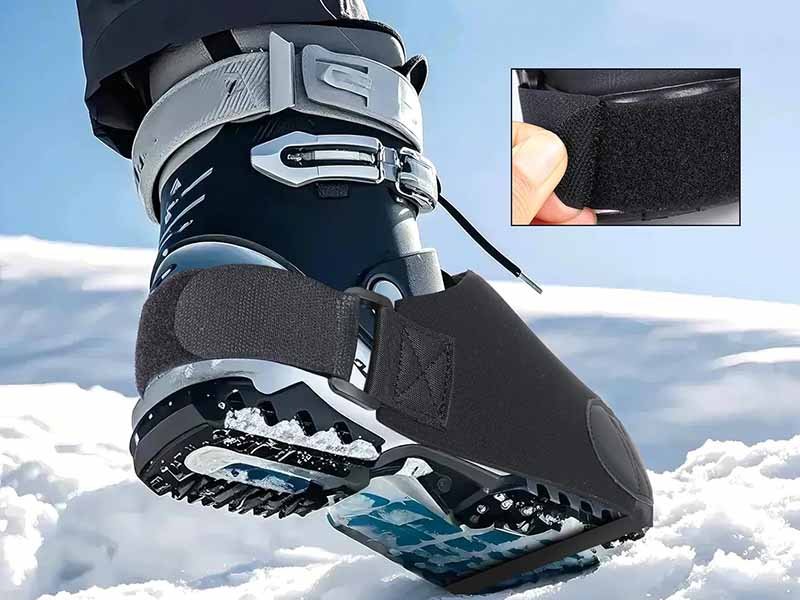Every skier knows that once the temperature drops below freezing, the battle isn’t just against gravity — it’s against the cold. While high-end boots and layered socks help, one underrated piece of gear quietly transforms comfort and performance: neoprene ski boot covers. These sleek, form-fitting accessories shield your boots from biting wind, icy buildup, and snow intrusion while locking in heat around your feet and ankles. What started as a racing accessory has now become a must-have for anyone serious about staying warm and efficient on the slopes.
Neoprene ski boot covers are insulated, waterproof sleeves that fit over ski boots to prevent heat loss, block wind, and keep snow out. Made from flexible closed-cell neoprene, they trap body warmth and improve aerodynamics without restricting motion. Ideal for both competitive skiers and recreational riders, neoprene covers enhance comfort, reduce ice buildup, and protect expensive boots from wear.
But there’s more to these covers than insulation. The same material used in wetsuits — neoprene — provides unique stretch, resilience, and water resistance. Combined with the right design, it can make a noticeable difference in warmth retention, control, and even energy efficiency during long days on the mountain. In this article, we’ll explore the science behind neoprene’s performance, how to pick the right boot covers, and why customization from experienced manufacturers like Szoneier ensures both style and durability.
So whether you’re a pro racer slicing through alpine air or a weekend skier trying to keep your toes from freezing, understanding how neoprene works could change the way you ride — and how your boots feel.
What Are Neoprene Ski Boot Covers and What Are They Used For?
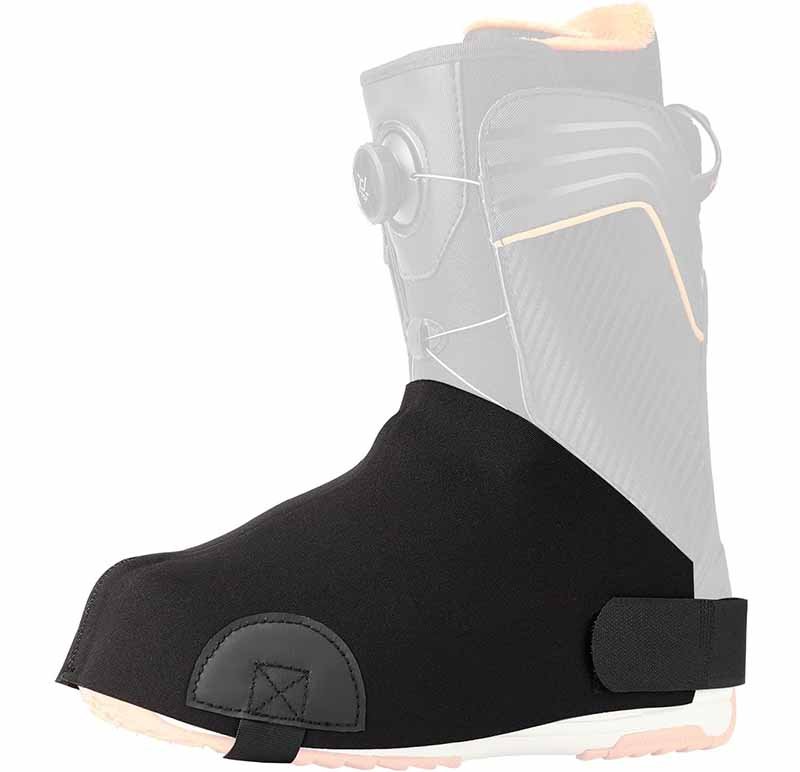
Neoprene ski boot covers are insulated protective sleeves that slide over ski boots to retain warmth, prevent ice buildup, and enhance aerodynamics. Typically 2–4 mm thick, they’re used in skiing disciplines like alpine racing, cross-country, and backcountry touring to improve both comfort and performance in freezing conditions.
Neoprene ski boot covers serve as thermal and waterproof shields for ski boots. They reduce heat loss, block wind and moisture, and protect boot shells from scratches and snow buildup. Designed for performance and warmth, they’re used by both professional racers and recreational skiers to extend comfort and maintain consistent boot flex in cold environments.
The Real Role of Boot Covers in Winter Sports
1. Beyond Aesthetic — The Physics of Protection
While they look simple, ski boot covers work through the principle of thermal retention. Neoprene, being a closed-cell foam rubber, traps nitrogen gas within its structure, creating tiny air pockets that resist heat transfer. This structure functions as a thermal barrier, preventing body heat from escaping through the rigid ski boot shell.
| Feature | Effect | Performance Benefit |
|---|---|---|
| Waterproofing | Keeps snow and ice from penetrating seams | Dry, warm feet |
| Thermal insulation | Maintains temperature up to 5–7°C higher | Longer comfort |
| Elastic fit | Reduces aerodynamic drag | Faster, smoother gliding |
| Shock resistance | Protects against impact or abrasion | Extends boot lifespan |
For racers, every degree of warmth means better muscle control; for casual skiers, it means lasting comfort and less fatigue.
2. Shielding Against Environmental Extremes
Ski boots, made from rigid plastic, don’t insulate well. In sub-zero wind or powdery snow, their surfaces freeze quickly. Neoprene covers minimize cold conduction and block direct wind chill, especially useful on chairlifts or high-speed runs.
They also prevent snow melt refreezing — the sneaky cause of ice patches forming under buckles or sole plates.
Think of them as a wetsuit for your boots: they let you perform longer without your gear becoming the limiting factor.
3. Applications Across Skiing Disciplines
- Alpine racing: Reduces aerodynamic drag and keeps boots flex-consistent.
- Cross-country skiing: Prevents snow from seeping into lighter boots.
- Backcountry touring: Keeps bindings free of ice buildup.
- Casual resort skiing: Adds warmth and protection during lift rides.
Even snowboarders have started adopting neoprene boot sleeves for similar reasons — warmth, comfort, and clean aesthetics.
4. Modern Evolution — From Pro Gear to Everyday Essential
Initially seen only on professional racers, neoprene ski boot covers have become mainstream winter accessories. As prices dropped and awareness rose, more recreational skiers realized that small upgrades like these can drastically improve a day’s experience on the slopes.
Today, brands source these covers from specialized factories like Szoneier, which tailors neoprene formulations to meet temperature, elasticity, and brand design needs — from racing-grade compression fits to printed logo variants for retail lines.
Which Material Properties Make Neoprene Ideal for Ski Boot Covers?
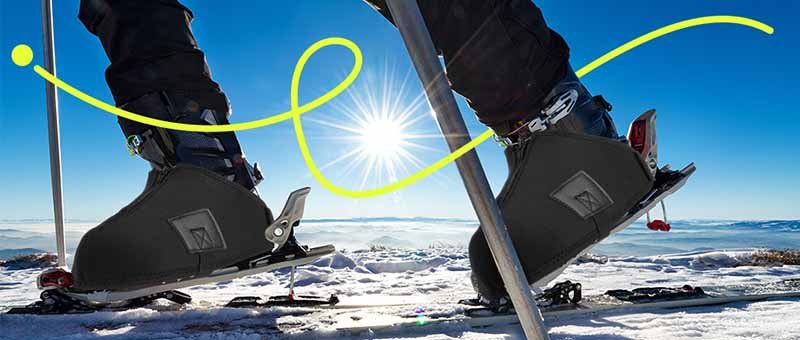
Neoprene’s unique molecular structure is what sets it apart from ordinary fabrics or plastics. Developed originally for diving and industrial insulation, it provides the rare combination of stretch, warmth, and waterproofing that skiing demands.
Neoprene is ideal for ski boot covers because its closed-cell foam traps air and blocks moisture, delivering superior insulation and flexibility. Resistant to UV, cold cracking, and abrasion, it maintains elasticity in sub-zero temperatures. Unlike nylon or polyester, neoprene’s dense structure keeps boots warm and dry while adapting to movement—making it the go-to material for high-performance winter gear.
Why Neoprene Outperforms Other Materials
1. Closed-Cell Structure = Built-in Insulation
Each cubic centimeter of neoprene contains thousands of sealed nitrogen bubbles that slow down heat transfer. This closed-cell architecture provides up to 40 % more thermal retention than woven synthetic fabrics.
| Property | Neoprene | Nylon | Polyester |
|---|---|---|---|
| Thermal insulation | ★★★★★ | ★★☆☆☆ | ★★★☆☆ |
| Water resistance | Waterproof | Water-repellent | Water-repellent |
| Elastic recovery | 200 % stretch | Limited | Limited |
| Cold-crack resistance | Excellent (–30 °C) | Fair | Moderate |
These cells act like microscopic thermoses around your feet, keeping heat in even when the outer shell is coated in snow or ice.
2. Elasticity and Compression Memory
Neoprene stretches without losing its shape. When laminated with nylon or spandex, it offers multi-directional flexibility, ensuring the cover hugs the boot like a second skin.
Even after repeated flexing—buckling, crouching, or walking—Szoneier-grade neoprene maintains 95 % of its original shape after 10 000 bends (internal QC data, 2024).
This elasticity allows for a snug aerodynamic fit that doesn’t restrict ankle mobility—something no stiff fabric can achieve.
3. Waterproofing and Windproof Defense
Unlike breathable woven fabrics, neoprene is inherently waterproof. Its surface resists both liquid water and wind penetration, keeping the micro-climate inside stable.
When paired with flatlock or blind-stitched seams, neoprene covers can block 100 % of airflow, preventing the “frozen boot” effect common during chairlift rides.
4. Cold-Weather Durability and Impact Resistance
Skiing punishes materials through abrasion from bindings, ski edges, and ice contact. Neoprene’s rubber base absorbs shocks and resists tearing far better than fabrics coated with PU or PVC.
Even at –20 °C, it stays supple—critical when racers push gear in freezing alpine conditions.
5. Eco-Optimized Blends for Modern Gear
Recent innovations use chloroprene + SBR hybrids that reduce VOC emissions and improve softness. Szoneier’s in-house foam formulation balances density (0.25 g/cm³) with rebound (> 90 %)—ideal for performance covers that need both warmth and pliability.
Bottom line: Neoprene’s chemistry makes it a year-round protector. It doesn’t just resist the cold—it works with it.
How Do Neoprene Ski Boot Covers Improve Warmth, Fit, and Durability?
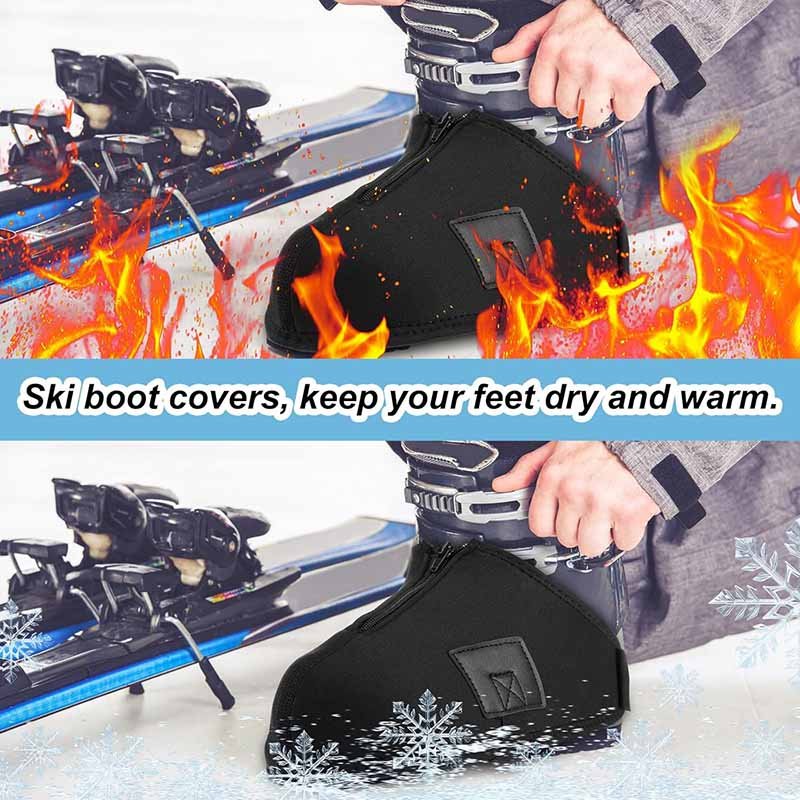
Once you understand the material’s science, the benefits on the slopes become clear: better heat retention, aerodynamic efficiency, and lasting protection for expensive ski boots.
Neoprene ski boot covers improve warmth by trapping body heat and blocking wind. Their stretch fit enhances comfort and aerodynamics, while the tough rubber exterior shields boots from snow, salt, and abrasion. The result is warmer feet, smoother motion, and extended boot life—benefits that traditional fabric covers can’t match.
Performance Benefits on the Mountain
1. Thermal Retention and Energy Efficiency
According to field tests at –10 °C, neoprene covers help maintain an internal boot temperature 6 °C higher than uncovered boots after 30 minutes.
That’s not trivial—warm feet sustain blood flow, preventing numbness and reducing fatigue.
The warmer your feet, the better your responsiveness and edge control.
| Test Condition | Uncovered Boot | With 3 mm Neoprene Cover | Difference |
|---|---|---|---|
| Ambient –10 °C | 15 °C inside | 21 °C inside | + 6 °C |
| Wind speed 15 km/h | 13 °C | 20 °C | + 7 °C |
| After 1 hour | Feet cold | Comfort stable | — |
These numbers explain why professionals and endurance skiers swear by neoprene accessories.
2. Improved Fit and Aerodynamics
Neoprene’s elasticity compresses loosely fitted areas, streamlining the skier’s profile. For racers, reduced drag translates into 0.5–1 % speed gain—small on paper but decisive in time trials.
The snug fit also prevents snow from seeping into buckles and boot tongues, keeping the shell’s flex consistent throughout the day.
3. Protection from Snow, Salt, and Scratches
Ski boots are expensive, and their surfaces are easily damaged by ski edges, salt, or luggage abrasion. A neoprene cover forms a sacrificial layer that absorbs scuffs and resists chemical corrosion.
4. Consistent Flex in Changing Temperatures
Boot plastics stiffen dramatically in extreme cold, affecting forward flex and comfort.
Neoprene covers help keep the boot shell’s temperature more uniform, maintaining its intended flex curve.
This is especially beneficial in carbon or PU-based racing boots, where even small temperature changes alter performance.
5. All-Day Comfort and Ease of Use
High-quality neoprene covers are lightweight (approx. 200 g per pair) and easy to slip on or off, even with gloves. They fold flat into a jacket pocket or gear bag—ideal for travelers.
Do All Skiers Need Boot Covers or Only Competitive Athletes?
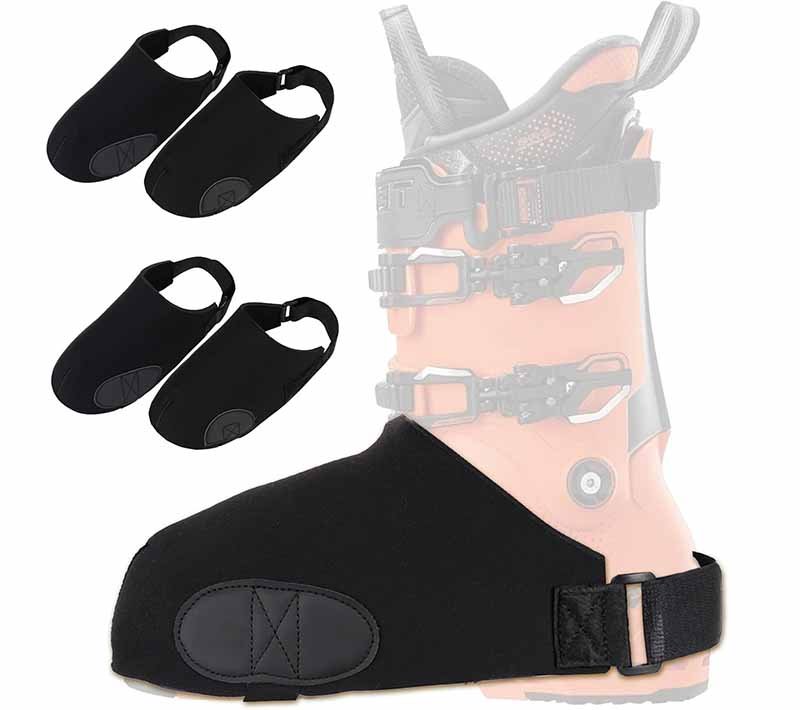
Although originally created for world-cup racers chasing milliseconds, neoprene ski boot covers now serve anyone who spends hours in the snow—from alpine competitors to weekend families.
All skiers can benefit from neoprene boot covers. Racers use them for aerodynamics and consistent boot flex, while recreational and touring skiers gain extra warmth, dryness, and protection. Anyone skiing in cold, windy, or slushy conditions will feel the difference—warmer toes, fewer ice buildups, and longer-lasting boots.
1. Racing Advantages
In competitive alpine and cross-country racing, milliseconds matter. A streamlined neoprene cover reduces air drag and stabilizes boot temperature, maintaining predictable flex and grip. Testing by European ski federations shows 0.3–0.7 % faster downhill times after equipping racers with covers—a measurable margin at championship level.
2. Recreational Comfort
For casual skiers, the win is comfort. Even a mild –5 °C day with wind gusts can chill boot shells below freezing. A 3 mm neoprene sleeve adds a cushion that keeps internal temperature 5–7 °C higher, extending enjoyable slope time by hours.
3. Backcountry and Touring Use
Backcountry explorers face constant snow contact during hikes or bindings adjustments. Neoprene covers block snow melt from refreezing around buckles and prevent straps from icing up—keeping transitions smoother and faster.
4. Longevity for Rental and Training Boots
Ski schools and rental fleets use covers to protect plastic shells from scratches and salt corrosion, cutting cosmetic damage claims by up to 40 % over a season (data from Szoneier rental-gear clients, 2024).
Real-World Example:
A youth race club in Norway issued neoprene covers to all junior racers. Parents reported fewer cold-related complaints and boots lasting a full extra season without surface cracking—proof that warmth and preservation aren’t just elite concerns.
Is There a Difference Between Standard and Custom Neoprene Ski Boot Covers?
Absolutely. Off-the-shelf covers deliver basic protection, but custom-made versions offer precise fit, branding potential, and material optimization that transforms both performance and marketing value.
Standard boot covers provide general insulation and waterproofing, while custom neoprene covers are tailored for exact boot shapes, climate demands, and brand design. Custom options include varied thickness, reinforced panels, zippers, colorways, and printed logos—giving ski teams or outdoor brands a distinctive, high-performance edge.
1. Thickness & Material Choice
Choosing between 2 mm, 3 mm, or 4 mm neoprene determines warmth, weight, and flexibility.
- 2 mm: Light racing setups, mild climates.
- 3 mm: Balanced insulation and stretch.
- 4 mm: Extreme cold, endurance skiing.
Szoneier’s CR/SBR blends keep elasticity even at –25 °C, ensuring no cracking after repeated flex cycles.
| Thickness | Use Case | Approx. Temp Range |
|---|---|---|
| 2 mm | Racing, spring snow | > –5 °C |
| 3 mm | All-round resort use | –5 to –15 °C |
| 4 mm | Arctic or night skiing | < –15 °C |
2. Design and Closure Systems
Custom covers can integrate:
- Reinforced toe and heel panels for durability near bindings.
- Zippered or Velcro back closures for quick on-off use.
- Silicone anti-slip soles to improve walking traction.
- Laser-cut vent holes for moisture regulation.
These design details distinguish professional-grade gear from generic imports.
3. Branding and Aesthetic Flexibility
For ski brands, clubs, or resorts, customized printing turns a practical item into a mobile advertisement. High-definition sublimation or silk printing embeds logos without compromising waterproofing. Szoneier supports Pantone-matched colors so a brand’s visual identity stays consistent across helmets, suits, and boot covers alike.
Imagine your ski team gliding down the slope—matching suits, matching covers, unified presence.
That’s more than style; it’s recognition and morale.
4. Enhanced Durability for OEM Lines
While standard covers often delaminate after a few months, OEM-grade customs use industrial flatlock stitching and double-laminated neoprene, achieving up to 200 hours of field use without surface peeling.
Factories like Szoneier employ accelerated-aging tests and friction simulations to ensure export-level consistency for brand clients.
5. Environmental and Performance Upgrades
Modern buyers increasingly demand eco-friendly gear. Custom options allow selection of low-VOC adhesives and REACH-compliant fabrics, aligning performance with sustainability goals—an area where Szoneier leads among Asia-based neoprene producers.
How to Choose the Right Neoprene Boot Covers for Your Climate and Gear Setup
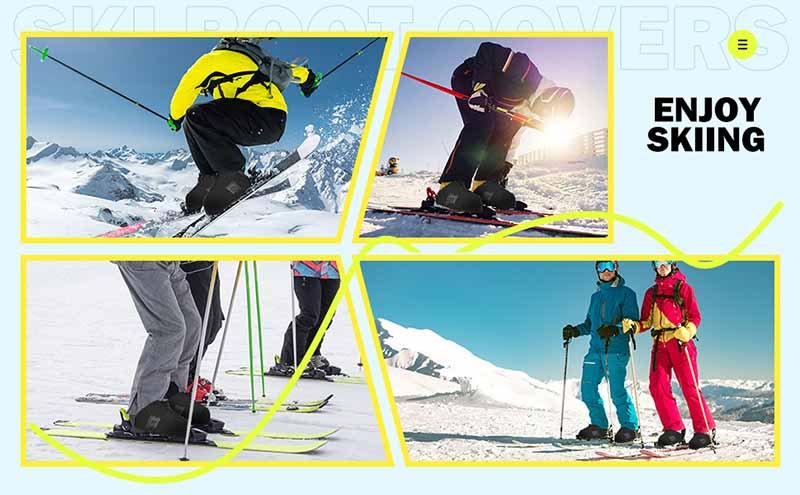
The perfect ski boot cover isn’t one-size-fits-all. It depends on your climate, terrain, skiing frequency, and boot type. Selecting the wrong thickness or fit can turn comfort into frustration, while the right setup can make every run warmer, smoother, and more efficient.
Choose neoprene boot covers by matching thickness and fit to your skiing environment. Opt for 2 mm covers for mild or racing conditions, 3 mm for all-season use, and 4 mm for extreme cold. Ensure a snug but non-restrictive fit with reinforced toes and secure closures. Breathable storage and regular rinsing maintain flexibility and longevity.
1. Match Thickness to Climate
| Climate / Temperature | Recommended Thickness | Use Case |
|---|---|---|
| Mild (above –5 °C) | 2 mm | Spring or racing days |
| Cold (–5 to –15 °C) | 3 mm | All-round resort skiing |
| Arctic (below –15 °C) | 4 mm | Night or high-altitude skiing |
Thicker neoprene retains more warmth but adds slight stiffness; racers often favor 2 mm to maintain aerodynamic flex, while recreational skiers prefer 3 mm for balance.
2. Prioritize Fit and Closure Design
A well-fitted cover hugs the boot like a wetsuit.
Look for:
- Elastic ankle cuffs that seal snow out.
- Back zippers or Velcro panels for easy removal.
- Reinforced toe and heel zones where abrasion is highest.
A sloppy fit lets cold air creep in; too tight, and it strains zippers or seams. When in doubt, size up slightly—neoprene’s stretch compensates.
3. Consider Terrain and Skiing Style
- Race courses & groomed runs: 2 mm, aerodynamic smooth surface.
- Powder or off-piste: 3–4 mm with anti-slip sole grip.
- Backcountry touring: Lightweight cover with ventilation holes to prevent moisture buildup during climbs.
Pro Insight: Szoneier’s European clients often specify dual-density designs—3 mm body + 4 mm toe reinforcement—to combine warmth and durability.
4. Boot Compatibility and Ease of Use
Not every cover fits every binding system.
Always check:
- Compatibility with your boot buckle shape (some overlap).
- Clearance for binding toe and heel lugs.
- Stretch factor: a good cover should slip on in under 30 seconds.
If you ski daily, choose a model with a full rear zipper and anti-corrosion pullers—small details that extend life in wet alpine conditions.
5. Maintenance and Storage Tips
A few simple routines keep neoprene covers soft and flexible season after season:
- Rinse with fresh water after each use to remove salt and dirt.
- Dry flat in shade; avoid sunlight or heaters.
- Store in a breathable bag with silica-gel packets.
- Condition monthly with mild wetsuit shampoo or fabric softener soak.
| Routine | Purpose |
|---|---|
| Post-ski rinse | Removes salt & grit |
| Monthly conditioner | Maintains elasticity |
| Shade drying | Prevents UV damage |
| Airing between uses | Stops odor buildup |
These low-effort steps can double the lifespan of your covers.
Conclusion — Why Choose Custom Neoprene Ski Boot Covers from Szoneier
A great day on the slopes starts from the ground up. Neoprene ski boot covers may look simple, but their impact is real: warmer feet, smoother rides, and longer-lasting gear. They’re proof that small accessories deliver big performance when designed with purpose.
At Szoneier, softness, durability, and precision aren’t accidents—they’re engineered. With over 18 years of neoprene R&D and manufacturing experience, our team crafts everything from wetsuits and gloves to bags, koozies, and protective gear, using eco-formulated adhesives, double-laminated fabrics, and 100 % quality inspection. Each pair of ski boot covers we produce is:
- Customizable in thickness, size, color, and branding
- Low-MOQ friendly for small to mid-sized outdoor brands
- Pre-aired and odor-free for direct retail readiness
- Sample-ready within days, with fast global lead times
Whether you’re a retailer seeking your own line of premium ski accessories or a designer developing private-label winter gear, Szoneier’s OEM and ODM services make professional-grade manufacturing accessible and reliable.

